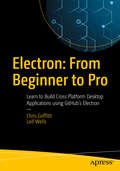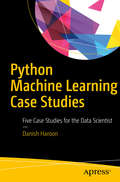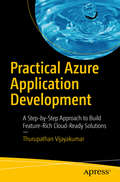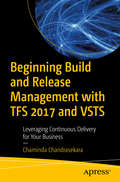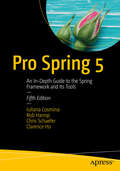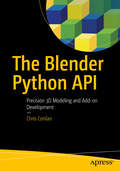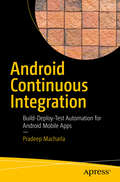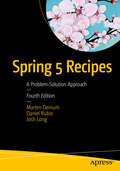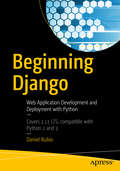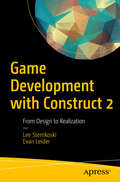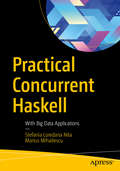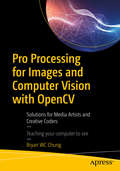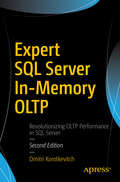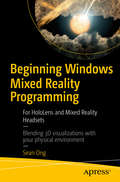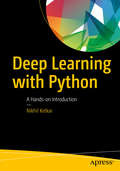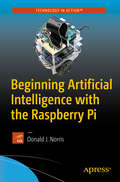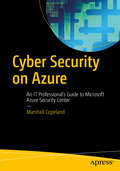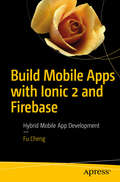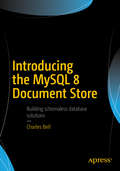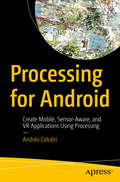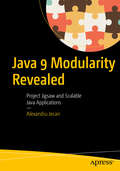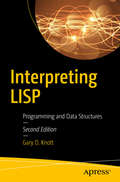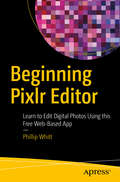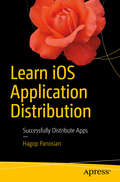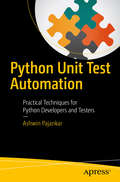- Table View
- List View
Electron: From Beginner to Pro
by Chris Griffith Leif WellsDiscover how to take your existing web development skills and learn how to create desktop applications for macOS, Windows, and Linux, using GitHub's Electron. Learn how to combine the power of Node. js and Chromium to provide a powerful development platform for creating web applications that break free from the browser. Electron: From Beginner to Pro guides you through the capabilities that you have available to create desktop applications. Learn to use features like file system access, create native menus, OS-specific dialogs and more. The authors will show you how to package your application for distribution for multiple platforms and enable auto-updating. What You Will Learn Leverage your knowledge of HTML, CSS and JavaScript Use current web applications for the desktop Create and use Electron's main process and render process to create effective desktop applications Communicate between processes and between windows Build desktop applications that can be updated and distributed Who This Book Is For Web developers looking to leverage their HTML, CSS and JavaScript skills to create desktop widgets and applications. Developers wanting to leverage existing a Web application to extend functionality with a desktop application.
Python Machine Learning Case Studies
by Danish HaroonEmbrace machine learning approaches and Python to enable automatic rendering of rich insights and solve business problems. The book uses a hands-on case study-based approach to crack real-world applications to which machine learning concepts can be applied. These smarter machines will enable your business processes to achieve efficiencies on minimal time and resources. Python Machine Learning Case Studies takes you through the steps to improve business processes and determine the pivotal points that frame strategies. You'll see machine learning techniques that you can use to support your products and services. Moreover you'll learn the pros and cons of each of the machine learning concepts to help you decide which one best suits your needs. By taking a step-by-step approach to coding in Python you'll be able to understand the rationale behind model selection and decisions within the machine learning process. The book is equipped with practical examples along with code snippets to ensure that you understand the data science approach to solving real-world problems. What You Will Learn Gain insights into machine learning concepts Work on real-world applications of machine learning Learn concepts of model selection and optimization Get a hands-on overview of Python from a machine learning point of view Who This Book Is For Data scientists, data analysts, artificial intelligence engineers, big data enthusiasts, computer scientists, computer sciences students, and capital market analysts.
Practical Azure Application Development
by Thurupathan VijayakumarGet started and learn a step-by-step approach to application development using Microsoft Azure. Select the right services to solve the problem at hand in a cost-effective manner and explore the potential different services and how they can help in building enterprise applications. Azure has an ample amount of resources and tutorials, but most of them focus on specific services and explain those services on their own and in a given context. Practical Azure Application Development focuses on building complete solutions on Azure using different services. This book gives you the holistic approach to Azure as a solutions development platform. This book: Covers Azure as a solution development platform for building applications Provides real-world examples to understand why and when an Azure service is required Discusses how Azure helps to achieve continuous improvement and expansion of an application Provides application development experience from purchasing Azure to integrating with core Azure services, including an introduction to DevOps with VSTS What You'll Learn Use Azure services to solve real-world software problems Define the usage of Azure services and select the right services to solve the problem at hand Make clear and less ambiguous decisions about using different Azure services Take a holistic approach to Azure as a solution platform Understand the basics of security, data protection, and cost controls in Azure Who This Book Is For Developers, software engineers, and architects who have experience in . NET and web development, but have little or no knowledge in planning and developing an application on Azure
Beginning Build and Release Management with TFS 2017 and VSTS
by Chaminda ChandrasekaraMaster build and release management with Team Foundation Service and Visual Studio Team Services to facilitate the continuous delivery of software updates to your development team.You'll receive detailed, practical guidance on automating website deployments in Azure App Service, database deployments to Azure platform, Micro Services deployments in Azure Service Fabric, and more. Each deployment is structured with the aid of hands-on lessons in a given target environment designed to empower your teams to achieve successful DevOps. This book provides lessons on how to optimize build release management definitions using capabilities, such as task groups. With the help of practical scenarios, you’ll also learn how to diagnose and fix issues in automated builds and deployments. You’ll see how to enhance the capability of build and release management, using team services/TFS Marketplace extensions and writing your own extensions for any missing functionality via hands-on lessons.What You Will LearnAutomate deployment to Azure platform, including Web App Service, Azure SQL and Azure Service FabricTest automation integration with builds and deploymentsPerform Dynamic CRM deployment handling and package management with TFS/VSTSExamine requirement to production delivery traceability in practical terms Review cross platform build/deployment capabilities of TFS/VSTS. Who This Book Is ForBuild/Release Engineers, Configuration Managers, Software Developers, Test Automation Engineers, System Engineers, Software Architects and System/Production Support Engineers or anyone who handles and involves in the software delivery process.
Pro Spring 5
by Iuliana Cosmina Rob Harrop Chris Schaefer Clarence HoPro Spring 2 is the perfect, simple answer for your lightweight, alternative Java EE development needs! Put simply, this book brings J2EE/Java EE "down to earth. " Without the hassles of using the EJB 3 specification and similar, you can build lighter, better-performing agile enterprise Java-based applications using Spring Framework 2. The Spring framework can also integrate other noteworthy and hot open source tools like Apache Struts, Hibernate, OpenJPA, GlassFish, and many more. You'll work through a real, scalable enterprise application and build it from the ground up with Spring, using all the multiple web views and frameworks.
The Blender Python API
by Chris ConlanUnderstand Blender's Python API to allow for precision 3D modeling and add-on development. Follow detailed guidance on how to create precise geometries, complex texture mappings, optimized renderings, and much more.This book is a detailed, user-friendly guide to understanding and using Blender’s Python API for programmers and 3D artists. Blender is a popular open source 3D modeling software used in advertising, animation, data visualization, physics simulation, photorealistic rendering, and more. Programmers can produce extremely complex and precise models that would be impossible to replicate by hand, while artists enjoy numerous new community-built add-ons.The Blender Python API is an unparalleled programmable visualization environment. Using the API is made difficult due to its complex object hierarchy and vast documentation. Understanding the Blender Python API clearly explains the interface. You will become familiar with data structures and low-level concepts in both modeling and rendering with special attention given to optimizing procedurally generated models. In addition, the book:Discusses modules of the API as analogs to human input modes in BlenderReviews low-level and data-level manipulation of 3D objects in Blender PythonDetails how to deploy and extend projects with external librariesProvides organized utilities of novel and mature API abstractions for general use in add-on developmentWhat You’ll LearnGenerate 3D data visualizations in Blender to better understand multivariate data and mathematical patterns.Create precision object models in Blender of architectural models, procedurally generated landscapes, atomic models, etc.Develop and distribute a Blender add-on, with special consideration given to careful development practicesPick apart Blender’s 3D viewport and Python source code to learn about API behaviorsDevelop a practical knowledge of 3D modeling and rendering conceptsHave a practical reference to an already powerful and vast APIWho This Book Is ForPython programmers with an interest in data science, game development, procedural generation, and open-source programming as well as programmers of all types with a need to generate precise 3D models. Also for 3D artists with an interest in programming or with programming experience and Blender artists regardless of programming experience.
Android Continuous Integration: Build-Deploy-Test Automation for Android Mobile Apps
by Pradeep MacharlaMaster continuous integration, deployment and automated testing for Android apps. You'll see how to set up and tear down sandbox environments to test the end-user experience, where you'll learn how to manage a mobile device in addition to the build machine. Android Continuous Integration applies a real-world CI pattern that has been thoroughly tested and implemented. This book starts with continuous integration concepts and the tools and code needed to become proficient in continuous integration for Android apps. You'll also follow acceptance test driven development (ATDD) best practice, giving you all the skills you need to become a better, more effective developer. Finally, you'll learn about the Appium mobile automation library and the Jenkins continuous integration tool. What You Will Learn Understand how to build an Android mobile app from source Set up a development or debuggi ng environment for mobile apps Integrate with the Nexus dependency management and application release tool Work with the SonarQube code quality analyzer Use debugging tools in Android Who This Book Is For Product owners/business analysts, QA/test engineers, developers and build/deploy engineers.
Spring 5 Recipes
by Marten Deinum Daniel Rubio Josh LongSolve all your Spring 5 problems using complete and real-world code examples. When you start a new project, you'll be able to copy the code and configuration files from this book, and then modify them for your needs. This can save you a great deal of work over creating a project from scratch. The recipes in Spring 5 Recipes cover Spring fundamentals such as Spring IoC container, Spring AOP/ AspectJ, and more. Other recipes include Spring enterprise solutions for topics such as Spring Java EE integration, Spring Integration, Spring Batch, Spring Remoting, messaging, transactions, and working with big data and the cloud using Hadoop and MongoDB. Finally, Spring web recipes cover Spring MVC, other dynamic scripting, integration with the popular Grails Framework (and Groovy), REST/web services, and more. You'll also see recipes on new topics such as Spring Framework 5, reactive Spring, Spring 5 microservices, the functional web framework and much more. This book builds upon the best-selling success of the previous editions and focuses on the latest Spring Framework features for building enterprise Java applications. What You'll Learn Get re-usable code recipes and snippets for core Spring, annotations and other development tools Access Spring MVC for web development Work with Spring REST and microservices for web services development and integration into your enterprise Java applications Use Spring Batch, NoSQL and big data for building and integrating various cloud computing services and resources Integrate Java Enterprise Edition and other Java APIs for use in Spring Use Grails code and much more Who This Book Is For Experienced Java and Spring programmers.
Beginning Django: Web Application Development and Deployment with Python
by Daniel RubioDiscover the Django web application framework and get started building Python-based web applications. This book takes you from the basics of Django all the way through to cutting-edge topics such as creating RESTful applications. Beginning Django also covers ancillary, but essential, development topics, including configuration settings, static resource management, logging, debugging, and email. Along with material on data access with SQL queries, you'll have all you need to get up and running with Django 1. 11 LTS, which is compatible with Python 2 and Python 3. Once you've built your web application, you'll need to be the admin, so the next part of the book covers how to enforce permission management with users and groups. This technique allows you to restrict access to URLs and content, giving you total control of your data. In addition, you'll work with and customize the Django admin site, which provides access to a Django project's data. After reading and using this book, you'll be able to build a Django application top to bottom and be ready to move on to more advanced or complex Django application development. What You'll Learn Get started with the Django framework Use Django views, class-based views, URLs, middleware, forms, templates, and Jinja templates Take advantage of Django models, including model relationships, migrations, queries, and forms Leverage the Django admin site to get access to the database used by a Django project Deploy Django REST services to serve as the data backbone for mobile, IoT, and SaaS systems Who This Book Is For Python developers new to the Django web application development framework and web developers new to Python and Django.
Game Development with Construct 2
by Lee Stemkoski Evan LeiderDesign and create video games using Construct 2. No prior experience is required. Game Development with Construct 2 teaches you to create 12 different game projects from a variety of genres, including car racing and tower defense to platformer and action-adventure. The software is user friendly and powerful, and the games you create can be exported to run on the web, desktop computers, and smartphones. What You'll Learn Create complete functional games using the Construct 2 game engine Understand general logical structures underlying video game programs Use practical game design advice (such as visual feedback and gameplay balancing) Understand programming concepts useful throughout computer science Who This Book Is For Middle school and high school students with no prior programming knowledge, and only minimal mathematical knowledge (graphing (x,y) coordinates, measuring angles, and applying formulas)
Practical Concurrent Haskell
by Stefania Loredana Nita Marius MihailescuLearn to use the APIs and frameworks for parallel and concurrent applications in Haskell. This book will show you how to exploit multicore processors with the help of parallelism in order to increase the performance of your applications. Practical Concurrent Haskell teaches you how concurrency enables you to write programs using threads for multiple interactions. After accomplishing this, you will be ready to make your move into application development and portability with applications in cloud computing and big data. You'll use MapReduce and other, similar big data tools as part of your Haskell big data applications development. What You'll Learn Program with Haskell Harness concurrency to Haskell Apply Haskell to big data and cloud computing applications Use Haskell concurrency design patterns in big data Accomplish iterative data processing on big data using Haskell Use MapReduce and work with Haskell on large clusters Who This Book Is For Those with at least some prior experience with Haskell and some prior experience with big data in another programming language such as Java, C#, Python, or C++.
Pro Processing for Images and Computer Vision with OpenCV: Solutions for Media Artists and Creative Coders
by Bryan Wc ChungApply the Processing language to tasks involved in computer vision--tasks such as edge and corner detection, recognition of motion between frames in a video, recognition of objects, matching of feature points and shapes in different frames for tracking purposes, and more. You will manipulate images through creative effects, geometric transformation, blending of multiple images, and so forth. Examples are provided.Pro Processing for Images and Computer Vision with OpenCV is a step-by-step training tool that guides you through a series of worked examples in linear order. Each chapter begins with a basic demonstration, including the code to recreate it on your own system. Then comes a creative challenge by which to engage and develop mastery of the chapter’s topic. The book also includes hints and tips relating to visual arts, interaction design, and industrial best practices.This book is intended for any developer of artistic and otherwise visual applications, such as in augmented reality and digital effects, with a need to manipulate images, and to recognize and manipulate objects within those images. The book is specifically targeted at those making use of the Processing language that is common in artistic fields, and to Java programmers because of Processing’s easy integration into the Java programming environment. What You'll LearnMake use of OpenCV, the open source library for computer vision in the Processing environmentCapture live video streams and examine them frame-by-frame for objects in motionRecognize shapes and objects through techniques of detecting lines, edges, corners, and moreTransform images by scaling, translating, rotating, and additionally through various distortion effectsApply techniques such as background subtraction to isolate motion of objects in live video streamsDetect and track human faces and other objects by matching feature points in different images or video framesWho This Book Is ForMedia artists, designers, and creative coders
Expert SQL Server In-Memory OLTP
by Dmitri KorotkevitchExpert SQL Server In-Memory OLTP is a deep dive into one of the most significant features of SQL Server 2014 - support for In-Memory Online Transaction Processing. The book describes the architecture and internals of the In-Memory OLTP Engine and explains how to develop, deploy, and maintain systems using it. With it you can dramatically increase transactional throughput to handle thousands of transactions per second supporting millions of customers. Dmitri Korotkevitch is the five-star author of Pro SQL Server Internals, and now brings his same combination of clear thinking and deep expertise to the question of how to recognize the opportunities and benefit from Microsoft's In-Memory OLTP feature set in SQL Server 2014. Learn the architecture and the internals in order to recognize when In-Memory OLTP can make a difference. Learn useful scenarios for thoughtfully incorporating in-memory support into existing applications. Recognize opportunities for In-Memory OLTP in new development. Don't be without Dmitri Korotkevitch and the deep expertise he imparts in Expert SQL Server In-Memory OLTP as you move forward in using SQL Server's new and important In-Memory OLTP feature set. Covers In-Memory OLTP internals and architecture, including data storage, indexing, multi-version concurrency control, transaction logging, and recovery Illustrates In-Memory OLTP programmability and the process of native compilation Guides in using In-Memory OLTP in new development and existing systems.
Beginning Windows Mixed Reality Programming: For HoloLens and Mixed Reality Headsets
by Sean OngDevelop applications and experiences for Microsoft's HoloLens and other Windows mixed reality devices. This easy-to-follow guide removes the mystery behind creating amazing augmented reality experiences. Mixed reality development tools and resources are provided. Beginning Windows Mixed Reality Programming clearly explains all the nuances of mixed reality software development. You'll learn how to create 3D objects and holograms, interact with holograms using voice commands and hand gestures, use spatial mapping and 3D spatial sound, build with Microsoft's HoloToolkit, create intuitive user interfaces, and make truly awe-inspiring mixed reality experiences. Start building the holographic future today! What You Will Learn Prototype ideas quickly Get started with Unity, the preferred tool for animating 3D objects. Explore where to find 3D models for your project, or make your own! Use spatial sound, voice commands, and gestures Build with the HoloToolkit to make apps the easy way Publish to the Windows Store and make money from your app Who This Book Is For Programmers with little or no graphics or mixed reality experience
Deep Learning with Python
by Nikhil KetkarDiscover the practical aspects of implementing deep-learning solutions using the rich Python ecosystem. This book bridges the gap between the academic state-of-the-art and the industry state-of-the-practice by introducing you to deep learning frameworks such as Keras, Theano, and Caffe. The practicalities of these frameworks is often acquired by practitioners by reading source code, manuals, and posting questions on community forums, which tends to be a slow and a painful process. Deep Learning with Python allows you to ramp up to such practical know-how in a short period of time and focus more on the domain, models, and algorithms.This book briefly covers the mathematical prerequisites and fundamentals of deep learning, making this book a good starting point for software developers who want to get started in deep learning. A brief survey of deep learning architectures is also included.Deep Learning with Python also introduces you to key concepts of automatic differentiation and GPU computation which, while not central to deep learning, are critical when it comes to conducting large scale experiments. What You Will Learn Leverage deep learning frameworks in Python namely, Keras, Theano, and Caffe Gain the fundamentals of deep learning with mathematical prerequisites Discover the practical considerations of large scale experiments Take deep learning models to productionWho This Book Is ForSoftware developers who want to try out deep learning as a practical solution to a particular problem. Software developers in a data science team who want to take deep learning models developed by data scientists to production.
Beginning Artificial Intelligence with the Raspberry Pi
by Donald J. NorrisGain a gentle introduction to the world of Artificial Intelligence (AI) using the Raspberry Pi as the computing platform. Most of the major AI topics will be explored, including expert systems, machine learning both shallow and deep, fuzzy logic control, and more! AI in action will be demonstrated using the Python language on the Raspberry Pi. The Prolog language will also be introduced and used to demonstrate fundamental AI concepts. In addition, the Wolfram language will be used as part of the deep machine learning demonstrations. A series of projects will walk you through how to implement AI concepts with the Raspberry Pi. Minimal expense is needed for the projects as only a few sensors and actuators will be required. Beginners and hobbyists can jump right in to creating AI projects with the Raspberry PI using this book. What You'll Learn What AI is and--as importantly--what it is not Inference and expert systems Machine learning both shallow and deep Fuzzy logic and how to apply to an actual control system When AI might be appropriate to include in a system Constraints and limitations of the Raspberry Pi AI implementation Who This Book Is For Hobbyists, makers, engineers involved in designing autonomous systems and wanting to gain an education in fundamental AI concepts, and non-technical readers who want to understand what AI is and how it might affect their lives.
Cyber Security on Azure: An IT Professional’s Guide to Microsoft Azure Security Center
by Marshall CopelandPrevent destructive attacks to your Azure public cloud infrastructure, remove vulnerabilities, and instantly report cloud security readiness. This book provides comprehensive guidance from a security insider's perspective. Cyber Security on Azure explains how this 'security as a service' (SECaaS) business solution can help you better manage security risk and enable data security control using encryption options such as Advanced Encryption Standard (AES) cryptography. Discover best practices to support network security groups, web application firewalls, and database auditing for threat protection. Configure custom security notifications of potential cyberattack vectors to prevent unauthorized access by hackers, hacktivists, and industrial spies. What You'll Learn This book provides step-by-step guidance on how to: Support enterprise security policies Improve cloud security Configure intrusion detection Identify potential vulnerabilities Prevent enterprise security failures Who This Book Is For IT, cloud, and security administrators; CEOs, CIOs, and other business professionals
Build Mobile Apps with Ionic 2 and Firebase
by Fu ChengLearn to build hybrid mobile apps using Ionic and Firebase. You'll build a Hacker News client app, which can view top stories in Hacker News, view comments of a story, add stories to favorites, etc. This introductory guide covers the whole cycle of hybrid mobile apps development. It's organized around implementing different user stories. For each story, this book not only talks about how to implement it but also explains related Ionic and Firebase concepts in detail. Using Apache Cordova, developers can create a new type of mobile app—a hybrid mobile app.Hybrid mobile apps actually run in an internal browser inside a wrapper created by Apache Cordova. With hybrid mobile apps, developers can have one single code base for different platforms. Developers also can use their existing web development skills. The Ionic framework builds on top of Apache Cordova and provides out-of-box components which make developing hybrid mobile apps much easier. Ionic uses Angular as the JavaScript framework and has a nice default UI style with a similar look and feel to native apps. Firebase is a realtime database which can be accessed in web apps using JavaScript. With Build Mobile Apps with Ionic 2 and Firebase you'll discover that just need to develop front-end code, there's no need to manage any back-end code or servers. What You'll Learn Create content-based Ionic mobile apps Discover the advanced features of the Ionic framework Use Firebase as a mobile app’s back-end storage Build, test, and continuously delivery Ionic mobile apps Publish and analyze Ionic mobile appsWho This Book Is ForFront-end developers and mobile app developers
Introducing the MySQL 8 Document Store
by Charles BellLearn the new Document Store feature of MySQL 8 and build applications around a mix of the best features from SQL and NoSQL database paradigms. Don’t allow yourself to be forced into one paradigm or the other, but combine both approaches by using the Document Store. MySQL 8 was designed from the beginning to bridge the gap between NoSQL and SQL. Oracle recognizes that many solutions need the capabilities of both. More specifically, developers need to store objects as loose collections of schema-less documents, but those same developers also need the ability to run structured queries on their data. With MySQL 8, you can do both! Introducing the MySQL 8 Document Store presents new tools and features that make creating a hybrid database solution far easier than ever before. This book covers the vitally important MySQL Document Store, the new X Protocol for developing applications, and a new client shell called the MySQL Shell. Also covered are supporting technologies and concepts such as JSON, schema-less documents, and more. The book gives insight into how features work and how to apply them to get the most out of your MySQL experience. The book covers topics such as:The headline feature in MySQL 8MySQL's answer to NoSQLNew APIs and client protocolsWhat You'll LearnCreate NoSQL-style applications by using the Document StoreMix the NoSQL and SQL approaches by using each to its best advantage in a hybrid solutionWork with the new X Protocol for application connectivity in MySQL 8Master the new X Developer Application Programming InterfacesCombine SQL and JSON in the same database and applicationMigrate existing applications to MySQL Document StoreWho This Book Is ForDevelopers and database professionals wanting to learn about the most profound paradigm-changing features of the MySQL 8 Document Store
Processing for Android: Create Mobile, Sensor-Aware, and VR Applications Using Processing
by Andrés ColubriLearn how to use the Processing programming language and environment to create Android applications with ease. This book covers the basics of the Processing language, allowing users to effectively program interactive graphics in 2D and 3D. It also details the application of these techniques to different types of Android devices (smartphones, tablets, wearables and smartwatches). Processing for Android walks you through the steps of taking an initial idea to a final app. With this book, you will be able to write engaging apps with interactive visuals driven by motion and location information obtained from the device’s sensors; including health data from the wearer, like step count and heart rate. An advantage of Processing for Android over more complex programming environments is the ability for users to focus on the interactions and visual output of their code rather than in the implementation details of the Android platform. This book goes through a comprehensive series of hand-on projects, ranging from simple sketches to more complex projects involving sensors and integration with larger apps. It also covers important aspects such as exporting your Processing projects as signed apps are ready to upload to the Google Play store and be share with the world!What You'll LearnWrite apps and live wallpapers for smartphones and tabletsDesign and implement interactive watch facesCreate Virtual Reality experiences for Cardboard devicesIntegrate Processing sketches into larger apps and Android StudioExport projects as completed apps ready to distribute through Google Play StoreWho This Book Is ForArtists, designers, students, researchers, and hobbyists who are not necessarily Android experts, but are looking to write mobile apps that make creative use of interactive graphics, sensor data, and virtual reality.
Java 9 Modularity Revealed
by Alexandru JecanDevelop modular applications using the Java Platform Module System, the single most anticipated feature in Java 9. You will improve maintainability and performance of your Java applications by deploying only modules that are needed and encapsulating their implementation details. Until now Java has been monolithic. Using any one part of Java has meant incorporating the entirety of the runtime environment, an approach ill-suited to the increasing number of IoT devices such as fitness monitors, kitchen appliances, toys and games, and so forth. This book shows a new way, to make Java scale from the smallest of footprints in the smallest of devices through desktop PCs and on up to server platforms. With Java 9 Modularity Revealed you will learn to make your projects more reliable and scalable than ever using the most important feature in Java 9—The Java Platform Module System, known more commonly as Project Jigsaw. You will learn how to avoid one of the major pain points of Java programming, that of conflicting class names from different modules, or packages. You will learn to create custom run-time images that represent a minimal and more compact JRE containing only those modules that you need. You will further learn to migrate existing Java applications to modular ones using different approaches and tools. The end result is a new ability to plug together different modules without fear of namespace and other conflicts, and you can deploy to everything from small devices to large servers. This book provides code examples and explanations.What You'll Learn Build Java applications using the new modular system introduced in Java 9 Create your own JRE consisting only of the modules that you require Adapt your testing techniques toward modular applicationslare your dependencies on other modules Enable modules to export only specific packages Migrate existing Java applications to modular ones Improve maintainability and performance of Java applicationsWho This Book Is ForExperienced Java programmers wanting to keep up and become informed on the new modularity support in Java 9
Interpreting LISP
by Gary D. KnottLearn Lisp programming in a data structures context, including tables, functions, forms, expressions, typed-pointers, I/O, garbage collection and some applications. This short primer contains a careful description of the data structures manipulated by Lisp functions. These data structures and others, notably hash tables, are also used in constructing a Lisp interpreter. Interpreting Lisp will be of special interest to those learning and using programming languages and computer architecture as well as data structures. This book will be useful to autodidacts, professional programmers, and computer enthusiasts in a wide variety of fields. What You'll Learn Use the atom table and the number table in Lisp Master expressions, typed pointers, arguments and results in typed pointers, and more Write lambda expressions in Lisp Bind actual values to formal arguments Develop games in Lisp Who This Book Is For Experienced programmers new to Lisp.
Beginning Pixlr Editor: Learn to Edit Digital Photos Using this Free Web-Based App
by Phillip WhittLearn digital image editing without the expense of using subscription-based editors. This book will pave the way for you to leverage Pixlr Editor, a free, web-based image editing solution that works on virtually any computer platform. You'll learn image editing first hand by using the practice images with the corresponding tutorials--everything from creating simple graphics to enhancing and retouching photos. Explore all of the features you'd expect in a high end photo editing application; layers, history (multiple undos), and an array of powerful tools for handling almost any editing task. Powerful image editing used to require purchasing and installing expensive, complicated image editing software on your computer. Beginning Pixlr Editor takes an easy-to-access and convenient look at the alternative from the Pixlr family of tools and utilities and offers you advanced editing techniques so you can enhance, retouch, and edit your digital images like a pro. What You'll Learn: Easily access Pixlr Editor from any computer with a high speed Internet connection Create an new image, or open an image from your computer, a URL, or the Pixlr library Save your images on to your computer or the Pixlr library Navigate the the Pixlr interface Use the Tools, Layers, image Adjustments, History, and much more Who This Book Is For: Beginner and those with some image editing experience (anyone accustomed to Adobe Photoshop will instantly feel at home with Pixlr Editor).
Learn iOS Application Distribution
by Hagop PanosianCover every aspect of the app industry, from app idea generation through to marketing and performance monitoring. With this book you'll receive complete, reliable, up-to-date, and professional information and guidance. Learn iOS App Distribution is every developers thorough and accessible guide to successfully distributing apps. For readers who already know how to code and create apps, this book explains how the app industry works, how it is evolving, and what the key trends are. Rather than focus on the well-covered aspects of working with Swift and Xcode, you'll instead discover what it takes from a commercial standpoint to bring an app together and get it successfully out to customers. All the key technical aspects are simplified for you with non-technical backgrounds, and vast amounts of information are condensed into easy-to-understand visuals. What You'll Learn Review how the app industry nuances and how it works Analyze app statistics and key market trends Position an app appropriately within the industry Improve app performance and related products and services Who This Book Is For App designers, UI/UX design professionals, coders, app marketers, game designers, asset designers and app publishing companies. The book is also suitable for inventors and non-tech readers unfamiliar with the industry but interested in investing in apps
Python Unit Test Automation
by Ashwin PajankarQuickly learn how to automate unit testing of Python 3 code with Python 3 automation libraries, such as doctest, unittest, nose, nose2, and pytest. This book explores the important concepts in software testing and their implementation in Python 3 and shows you how to automate, organize, and execute unit tests for this language. This knowledge is often acquired by reading source code, manuals, and posting questions on community forums, which tends to be a slow and painful process. Python Unit Test Automation will allow you to quickly ramp up your understanding of unit test libraries for Python 3 through the practical use of code examples and exercises. All of which makes this book a great resource for software developers and testers who want to get started with unit test automation in Python 3 and compare the differences with Python 2. This short work is your must-have quick start guide to mastering the essential concepts of software testing in Python. What You'll Learn: Essential concepts in software testing Various test automation libraries for Python, such as doctest, unittest, nose, nose2, and pytest Test-driven development and best practices for test automation in Python Code examples and exercises Who This Book Is For: Python developers, software testers, open source enthusiasts, and contributors to the Python community
